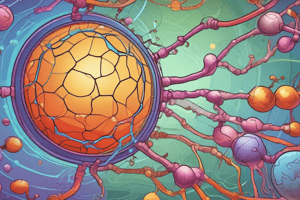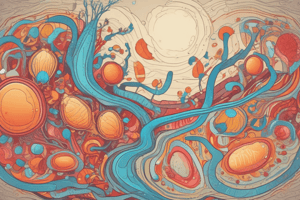Podcast
Questions and Answers
Which molecule is primarily used by cells as a source of metabolic energy?
Which molecule is primarily used by cells as a source of metabolic energy?
- Glucose
- ATP (correct)
- NADH
- Pyruvate
What is the net gain of ATP molecules in glycolysis from one glucose molecule?
What is the net gain of ATP molecules in glycolysis from one glucose molecule?
- 4 ATP
- 2 ATP (correct)
- 8 ATP
- 36 ATP
The first law of thermodynamics in biological systems is often exemplified by which of the following?
The first law of thermodynamics in biological systems is often exemplified by which of the following?
- Creation of energy during photosynthesis
- Conversion of chemical energy to mechanical energy (correct)
- Increase of entropy in isolated systems
- Direct transfer of high-energy phosphate groups
Which of the following best describes the role of chemiosmotic coupling in cellular respiration?
Which of the following best describes the role of chemiosmotic coupling in cellular respiration?
Gibbs free energy in biological systems is used to predict:
Gibbs free energy in biological systems is used to predict:
What is the primary outcome of the citric acid cycle in cellular metabolism?
What is the primary outcome of the citric acid cycle in cellular metabolism?
Which process describes the conversion of light energy into chemical energy in plants?
Which process describes the conversion of light energy into chemical energy in plants?
In gluconeogenesis, the body synthesizes glucose from:
In gluconeogenesis, the body synthesizes glucose from:
Which molecule is the final electron acceptor in the electron transport chain during aerobic respiration?
Which molecule is the final electron acceptor in the electron transport chain during aerobic respiration?
The synthesis of ATP by ATP synthase in the mitochondria is directly driven by:
The synthesis of ATP by ATP synthase in the mitochondria is directly driven by:
In photosynthesis, the electron transport through photosystem II is primarily coupled to:
In photosynthesis, the electron transport through photosystem II is primarily coupled to:
In gluconeogenesis, the conversion of pyruvate to glucose requires:
In gluconeogenesis, the conversion of pyruvate to glucose requires:
In polysaccharide synthesis, the activated form of glucose used is:
In polysaccharide synthesis, the activated form of glucose used is:
In fatty acid synthesis, the major product in eukaryotic cells is:
In fatty acid synthesis, the major product in eukaryotic cells is:
The carbon skeletons of amino acids are primarily derived from:
The carbon skeletons of amino acids are primarily derived from:
In protein biosynthesis, nitrogen is primarily incorporated in the form of:
In protein biosynthesis, nitrogen is primarily incorporated in the form of:
The starting point for nucleotide biosynthesis, both pyrimidine and purine, is:
The starting point for nucleotide biosynthesis, both pyrimidine and purine, is:
In the Calvin cycle, the primary function of Ribulose-1,5-bisphosphate (RuBP) is:
In the Calvin cycle, the primary function of Ribulose-1,5-bisphosphate (RuBP) is:
Antimetabolites, such as 6-mercaptopurine, are effective in cancer treatment because they:
Antimetabolites, such as 6-mercaptopurine, are effective in cancer treatment because they:
The activity of Aspartate Transcarbamoylase (ATC) is regulated by:
The activity of Aspartate Transcarbamoylase (ATC) is regulated by:
Which of the following is a precursor for both purine and pyrimidine nucleotide synthesis?
Which of the following is a precursor for both purine and pyrimidine nucleotide synthesis?
Which process converts atmospheric nitrogen (N2) to ammonia (NH3)?
Which process converts atmospheric nitrogen (N2) to ammonia (NH3)?
The synthesis of fatty acids in the human body primarily occurs in the:
The synthesis of fatty acids in the human body primarily occurs in the:
During protein synthesis, the formation of peptide bonds is energetically driven by the hydrolysis of:
During protein synthesis, the formation of peptide bonds is energetically driven by the hydrolysis of:
Why are antimetabolites like 6-mercaptopurine effective in cancer treatment?
Why are antimetabolites like 6-mercaptopurine effective in cancer treatment?
Which of the following is an end product of glycolysis?
Which of the following is an end product of glycolysis?
In the Calvin cycle, the enzyme Ribulose-1,5-bisphosphate carboxylase/oxygenase (Rubisco) catalyzes the:
In the Calvin cycle, the enzyme Ribulose-1,5-bisphosphate carboxylase/oxygenase (Rubisco) catalyzes the:
Which amino acid is directly synthesized from the citric acid cycle intermediate α-ketoglutarate?
Which amino acid is directly synthesized from the citric acid cycle intermediate α-ketoglutarate?
In the mitochondrial electron transport chain, the final electron acceptor is:
In the mitochondrial electron transport chain, the final electron acceptor is:
In animal cells, glucose is stored in the form of:
In animal cells, glucose is stored in the form of:
The principal site of fatty acid synthesis in eukaryotic cells is
The principal site of fatty acid synthesis in eukaryotic cells is
In photosynthesis, which molecule acts as the final electron acceptor in the light reactions?
In photosynthesis, which molecule acts as the final electron acceptor in the light reactions?
In glycolysis, the step involving the conversion of fructose-6-phosphate to fructose-1,6-bisphosphate is catalyzed by:
In glycolysis, the step involving the conversion of fructose-6-phosphate to fructose-1,6-bisphosphate is catalyzed by:
In the nitrogen cycle, the conversion of atmospheric nitrogen (N2) to ammonia (NH3) is known as:
In the nitrogen cycle, the conversion of atmospheric nitrogen (N2) to ammonia (NH3) is known as:
During protein synthesis, the addition of each amino acid to the growing polypeptide chain is driven by the hydrolysis of:
During protein synthesis, the addition of each amino acid to the growing polypeptide chain is driven by the hydrolysis of:
In the synthesis of purine nucleotides, the carbon and nitrogen atoms of the purine ring are derived from:
In the synthesis of purine nucleotides, the carbon and nitrogen atoms of the purine ring are derived from:
In the Calvin cycle, the regeneration of Ribulose-1,5-bisphosphate (RuBP) requires
In the Calvin cycle, the regeneration of Ribulose-1,5-bisphosphate (RuBP) requires
Which enzyme is responsible for catalyzing the addition of nucleotides during DNA synthesis?
Which enzyme is responsible for catalyzing the addition of nucleotides during DNA synthesis?
The effectiveness of 6-mercaptopurine in cancer treatment is primarily due to its ability to:
The effectiveness of 6-mercaptopurine in cancer treatment is primarily due to its ability to:
The synthesis of the non-essential amino acid alanine from pyruvate requires:
The synthesis of the non-essential amino acid alanine from pyruvate requires:
What is the primary function of Photosystem II in the light reactions of photosynthesis?
What is the primary function of Photosystem II in the light reactions of photosynthesis?
How many ATP molecules are required for the conversion of two molecules of pyruvate to one molecule of glucose in gluconeogenesis?
How many ATP molecules are required for the conversion of two molecules of pyruvate to one molecule of glucose in gluconeogenesis?
During polysaccharide synthesis, glucose-1-phosphate reacts with which nucleotide to form an activated glucose intermediate?
During polysaccharide synthesis, glucose-1-phosphate reacts with which nucleotide to form an activated glucose intermediate?
In the biosynthesis of fatty acids, the addition of each two-carbon unit requires how many molecules of NADPH?
In the biosynthesis of fatty acids, the addition of each two-carbon unit requires how many molecules of NADPH?
Which citric acid cycle intermediate is a precursor for the synthesis of the amino acids glutamate and glutamine?
Which citric acid cycle intermediate is a precursor for the synthesis of the amino acids glutamate and glutamine?
Which process involves the conversion of atmospheric nitrogen (N2) to ammonia (NH3)?
Which process involves the conversion of atmospheric nitrogen (N2) to ammonia (NH3)?
6-Mercaptopurine is an effective cancer treatment due to its role as:
6-Mercaptopurine is an effective cancer treatment due to its role as:
In the biosynthesis of macromolecules, ATP is primarily used to:
In the biosynthesis of macromolecules, ATP is primarily used to:
The synthesis of nucleic acids involves which activated precursors?
The synthesis of nucleic acids involves which activated precursors?
Why are some enzymes used in gluconeogenesis different from those used in glycolysis?
Why are some enzymes used in gluconeogenesis different from those used in glycolysis?



